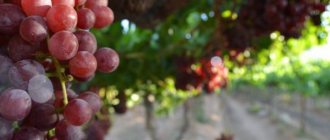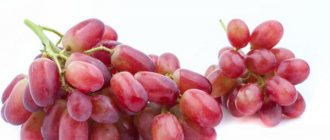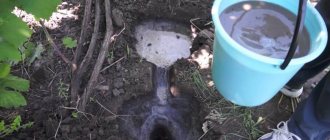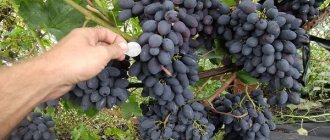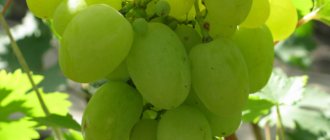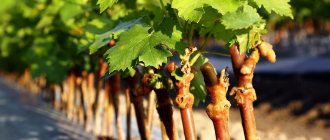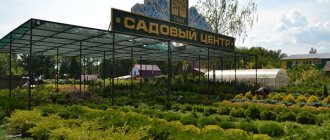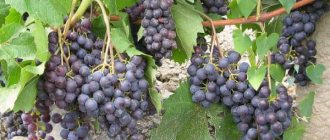General information about the variety
The creator of the variety is winegrower E. G. Pavlovsky. Rhombik was obtained by crossing two other hybrid forms - Krasotka and Super Extra. The grapes have good frost resistance, withstanding temperatures down to –23°C.
Did you know? According to scientists, the grapevine has existed for more than 65 million years. And 8,000 years ago, people began to actively interact with it, receiving juice, wine and, of course, delicious berries.
This grape has an extremely early ripening period - 80–90 days from the beginning of the growing season. The bushes give an excellent harvest already in mid-July. Conical clusters weighing up to 1 kg with dark, diamond-shaped berries look quite attractive. The value of the resulting variety is given by good transportable properties and high taste of the berries.
Detailed description of the Rombik variety:
- type - table;
- acidity - moderate;
- the color of the berries is dark purple, almost black;
- aroma - berry;
- yield - 15–17 kg of berries per bush;
- ripening time is 80–90 days.
Table varieties are intended for eating berries in their natural form. Therefore, it is better to grow these grapes for personal use and for sale. You can also use it to make wine, but this is not a priority for table varieties. The vigorous bushes of Rhombik branch well and surprise with their size. The vines ripen well even in the conditions of the Moscow region and more northern regions. The variety is resistant to diseases and requires only the usual treatments for grapes. The first harvest can be harvested the next year after planting in the ground.
History of selection
The grape variety appeared at the very beginning of the 21st century thanks to the activities of Evgeniy Georgievich Pavlovsky. The famous breeder presented gardeners with more than one fruit crop. This time Beauty and Super Extra were crossed, Rombik appeared, who took only the best properties from his parents. Thanks to long-term selection of plants, positive characteristics are preserved even during the development of shoots of subsequent generations.
See also
Description and rules for growing Atos grapes
Read
The hybrid is currently being tested on private plots. Many lovers of agricultural work speak favorably of the properties of the plant.
Fruit characteristics
The clusters are large, conical, medium loose, weighing about 0.8 kg. A special feature of the variety is that the berries stay quite firmly in the bunch and do not fall off. Diamond is not susceptible to peas and is characterized by smooth, almost identical berries, conical in shape. They contain quite a lot of seeds, the skin is dense and elastic.
Did you know? Grapes are an ideal food for diabetics, as their glycemic index is 46 (GI), which is 9 points lower than the diabetic norm.
—
55.
Dense pulp with a high juice content has a sugar content of about 14%. The taste is moderately sweet. The aroma is berry. The weight of the berries is 7–10 g. The variety is resistant to cracking. Ripe clusters can remain on the bushes for a long time. Over time, the berries may begin to dry out and turn into raisins.
Features of fruiting:
- It is recommended to leave 2 bunches on one shoot in order to improve the appearance and weight of individual specimens;
- clusters can ripen along the entire length of the shoot.
Description and features
Hybrid Rombik got its name for the shape of the fruits, which actually look like geometric shapes.
Vine
In the first year of life, Rhombik grapes produce one shoot. For the next season - several developed, elongated ones. It is on them that flowers and fruits appear.
The plant sometimes breaks under the weight of the brushes, so young bushes are secured on trellises or with the help of supports .
Inflorescences
The flowers of the Rombik grape are bisexual, white, small, collected in a complex inflorescence. There is no need to plant other pollinators near the vineyard.
Since the bush grows quickly and becomes massive, only two inflorescences are left on one shoot. This pruning allows you to give the grapes space. In addition, for a small number of berries there will be enough nutrients available to the plant. All this will allow the two bunches to ripen well.
Berries
The brushes of the plant have the following characteristics:
- The shape is regular, conical.
- Looseness is average.
- Weight ranges from 600 to 900 grams.
Rhombik fruits in clusters are not pressed too tightly, but at the same time keep their shape. This quality is good during harvest. The collected brushes fit tightly into the container, take up little space, and do not burst from the load.
The appearance of the hybrid berries is as follows:
- The shape resembles a rhombus with rounded corners.
- Weight can be more than 15 grams.
- As the grapes ripen, they acquire a dark purple color, which then turns black.
- There are a small number of seeds inside.
- The skin is thin.
The fruits of the Rombik hybrid are firmly attached to the stalks. Even after they are fully ripe, they do not fall off or crack, so some gardeners leave the berries on the vine until they turn into raisins. Thanks to knowledge of the nuances, you can get high-quality dried fruits without spending effort and resources on additional processing.
Taste
The dark pulp of the plant's fruit is moderately sweet, with a fruity tint. Tasting the grapes slowly reveals a rich note of juice reminiscent of juicy cherries. Thanks to the slight bitterness of the skin, a soft mixture of the pleasant taste of tender pulp and light sourness appears.
Growing regions
The Rombik hybrid is grown in the southern regions, in the Non-Black Earth Region, and in the Moscow region.
Advantages and disadvantages of the Rombik variety
- The main advantages of the variety:
- frost resistance;
- early ripeness;
- large fruit;
- high productivity;
- excellent taste;
- good transportability;
- resistance to diseases.
The main disadvantage of this grape can be considered the insufficient research of its properties and, accordingly, the lack of confirmed data on yield or susceptibility to specific diseases.
Pros and cons of the variety
Many gardeners highlight the disadvantages of the grape variety: its youth, the lack of professional recommendations for its cultivation. And also the fact that the fruits are not sugary enough. However, there are many more positive qualities:
- unusual taste;
- resistance to infections;
- good transportability;
- frost resistance and drought resistance;
- beautiful appearance of berries;
- early maturity and productivity.
A large number of advantages make the plant attractive to gardeners.
Landing Features
Grape bushes grow especially productively in sunny areas. But if you have an area with partial light, then it is also suitable for growing. Sunlight is essential for growth. Also keep in mind that the vine grows for more than 100 years and therefore needs free space that it will use throughout its life.
Important! Low-lying areas should not be used for planting grapes. Moisture stagnates there and due to dampness the bush will begin to ache, which will reduce the yield and may lead to its death.
The soil should be light and sandy. This ensures rapid drainage from the roots during rains. On dense clay soils, prepare a hole for planting, into which soil diluted with loose materials is added. Sand and perlite are used for dilution. The variety feels good on neutral soil, with an acidity of 5–7 pH.
Landing dates
When choosing a landing time, consider weather conditions. You need to be sure that sudden snow or frost will not destroy your plants with an insufficiently developed root system.
Therefore, seedlings are planted from May to August. The main tasks at this stage are to carry out the process so that the roots have the best conditions for rooting and have time to adapt to winter. In autumn, only adult Rombik bushes can be planted. The seedlings are planted in the morning. Cool, sunny weather is more favorable for planting than any other.
Important! Before winter, only non-covering varieties are allowed to be planted. They can survive the winter with a poorly developed root system.
Selecting a location
The site is selected taking into account the weather. If the region has cold and long winters, then be sure to choose the sunniest and southernmost area for planting. It must be well lit.
If it is uneven, then select a hill for planting. Frost pockets may form in low-lying areas of the yard or garden. The cold air that gets into them can stagnate for a long time, which is harmful for the bush, so grapes are not planted in the lowlands. If there is a hill, then you need to choose its southern slope.
The sloping area is also convenient because it drains water better than from a flat surface. The site should be protected from northern winds by buildings or trees. If the bush is planted next to a building, then you need to retreat from the wall at least 0.5–0.7 m for planting. If you plan to plant a vineyard, then plant it in a north-south direction. This will provide your plants with the best light levels for each shoot.
Soil requirements
You may think it's counterintuitive, but grapevines don't like soil that's high in nutrients. Therefore, choosing a location is more important, and the soil structure and nutritional value can be improved.
Sandy soil is considered the best for the following reasons:
- it is very light;
- warms up well in the sun;
- the roots develop in it without experiencing problems with advancement;
- Water quickly leaves it, which eliminates the possibility of root rotting.
In areas infested with weeds, it is necessary to destroy the weeds 1.5–2 months before planting by any method: chemical, mechanical. If you plant mustard on your plot in the fall, it will help suppress weeds.
Main characteristics
Hybrid Rombik has a number of positive characteristics.
Drought resistance
The drought resistance of the plants is good. Thanks to its powerful root system, the plant draws water deep from the soil. But lack of moisture negatively affects the vine. The grapes grow slowly, the leaf blades change color.
Young and improperly planted bushes suffer the most from drought.
Frost resistance
The Rombik hybrid is frost-resistant, can withstand frosts down to -25 ° C, but only if it is well covered.
Productivity and fruiting
The main advantage of the plant is that it has an extremely early ripening period. Already 3 months after the bushes awaken from hibernation, in the second decade of July, you can enjoy the first fruits. And in the southern regions - in early July.
In the description of the variety, producers state that the hybrid is high-yielding. But no one provided verified and documented data.
Areas of application of fruits
Rombik berries can be eaten fresh or dried. You can also make preparations for the winter from grapes - jams and compotes. The fruits of the plant are not suitable for making wine.
Resistance to diseases and pests
Manufacturers position the Rombik hybrid as resistant to major diseases and insect pests.
Caring for Rombik grapes
Caring for grapes consists of:
- glaze;
- removing weeds and loosening;
- trimmings;
- application of fertilizers;
- prevention of diseases and pests;
- harvesting.
It takes three years for the grapes to develop into a full-fledged bush from the moment of planting. Caring for young and mature bushes will be different. In the first year of growth, special attention is paid to weed removal and watering. Weeds actively consume nutrients and moisture from the soil.
The small root system of the grape bush is not able to compete with them and you will need to remove weeds and water the bushes quite often. Shallow digging will weaken the roots of grasses and cause their death. Regular weeding will significantly reduce their number. You don’t need to fertilize at this stage if you applied fertilizer to the bush when planting.
An adult bush is not afraid of weeds and does not depend on the frequency of watering. But it needs fertilizer, since those that you applied during planting have already been used. He also regularly needs molding and removal of stepsons.
Important! Do not fertilize late in the growing season. This will cause lush growth, the vines will not have time to woody in time for winter and may die.
It is recommended to fertilize once every 2-3 years, after the bush has exhausted its planting fertilizers. In the fall, before frosts, be sure to prune. Fruit-bearing shoots and unnecessary vines are removed. Before wintering, the bush is treated against pests.
Watering
Watering depends on the quality of the soil. Light sandy soil loses water more easily, so water more often. To prevent moisture loss, the root zone of the bush is covered with mulch - straw, spruce branches or other covering material. Heavy clay soils are watered less frequently. On average, they focus on 1 watering per week.
Therefore, monitor the condition of the soil. If it's dry, water it. There should be enough water to wet the soil to a depth of 15–25 cm. During the first year, the grapes should be watered weekly, unless it has rained and the soil is wet.
The efficiency of irrigation is affected by the method of introducing moisture. Thus, drip irrigation systems allow you to deliver moisture directly to the root zone using drippers. The method saves water, which also reduces the growth of weeds. With drip irrigation, water does not fall on the leaves, minimizing the occurrence of diseases due to waterlogging.
Read more about how to water grapes correctly and how often.
Preparing the plant for winter
To prevent the vines from freezing in winter, they are covered. Rombik is a frost-resistant variety, so you don’t have to cover it if the winter temperature does not drop below -20° C. You will also need to insulate the roots with mulch material (spruce branches, straw and a layer of soil) to protect them from frost.
Covering the vines for the winter is carried out according to the following instructions:
- To begin with, all the vines are disconnected from the trellis.
- Cut off all fruit-bearing shoots and remaining leaves.
- Treat the vines with copper sulfate.
- They dig a trench.
- The bottom is covered with film to protect it from moisture.
- They lay vines on it.
- Cover the vines with straw.
- Cover the top with soil.
In warm regions, in March the vines are unpacked and secured back to the trellis.
But this can also be done in early April (in cold regions). Did you know? Ampelotherapy
—
This is treatment using viticultural products: not only grapes, but also their seeds, leaves and even parts of the vine.
Prevention of pests and diseases
Disease prevention begins with injury prevention. Sweet berries are often damaged by birds. The sap in damaged areas attracts insects, and phytopathogens appear with them. And this can cause the bush to become infected. Therefore, the first priority protection is protection from birds. It is also necessary to regularly remove carrion so as not to attract insects.
Most pests hide in crevices and on the undersides of leaves. It is quite difficult to notice them. Therefore, gardeners place insect traps in order to start fighting them in time. Insecticidal treatment is carried out between June and August, if necessary.
Powdery mildew is prevented by ensuring a sufficient volume of air around the bush. Therefore, you should not thicken the plantings and save on the distance between the bushes. The Rhombik variety is considered resistant to diseases such as mildew and others characteristic of grape bushes.
Disease prevention consists of the following actions:
- be sure to provide a distance between bushes of at least 0.6 m;
- try not to get moisture on the leaves while watering;
- If signs of mold appear, remove the affected parts of the plant and fruits, and then treat with fungicides.
Important! Unlike other fruits or some vegetables, grape bunches cannot ripen.
Therefore, they are cut only when fully ripe.
Features of cultivation
Carefully inspect the seedling before purchasing; there should be no damage to it (breaks, peeling of bark, chips or stains). A healthy cutting has a branched, strong root, and the buds do not fall off when touched. The stem should be light brown and green when cut. Before planting, the roots of the seedling are soaked in water for 2–3 days, then they are shortened to 15 cm.
Allocate a place for the grapes on a hill or on a slope; do not plant the crop in lowlands or organize reliable drainage. The best option would be the southern, sunny, open side of the site, protected from wind and cold drafts. Rhombik grapes can be placed near fences and walls of various buildings, while it is advisable to arrange the supports in the form of an arch or gazebo.
Landing
The planting pit must be prepared in advance. Dig a hole measuring 80x80 cm, and add a layer (10–15 cm) of small crushed stone or broken stone to the bottom. Now fill the hole a little more than halfway with a mixture of soil and organic fertilizers, leave it for several months to shrink. You can add a half-liter jar of wood ash to the soil mixture.
Attention!
Rhombik grapes can be planted in the spring after return frosts or in the fall before the onset of frosts, but experienced winegrowers claim that spring planting is more suitable for this hybrid.
Make a small depression in the middle of the prepared hole; expect that after filling the roots with soil, the root collar will remain on the surface. For backfilling, use soil from a hole dug earlier. A peg for garter should be driven in next to the seedling. After planting, water the grapes generously; you will need 2 or 3 buckets of water.
Watering and fertilizing
At the beginning of growth (in the first year after planting), Rombik grapes need abundant watering; if there is no natural precipitation, pour 20 liters of water under the bush every 10–15 days. From mid-summer, the frequency of watering should be gradually reduced so that the vine has time to ripen before the first autumn frosts. In subsequent years, abundant watering is necessary only in the spring during the flowering period and during prolonged drought. After watering and rain, the soil needs to be loosened, and to prevent moisture from quickly evaporating, the tree trunk circle should be mulched with humus or peat.
Fertilizers added to the soil during planting will last for 3–5 years, then fertilizing is carried out regularly, several times throughout the entire grape growing season. In early spring (immediately after removing the cover), autumn, and also during the period of mass filling of berries, use chicken droppings, manure or plant humus. Before the flowers bloom and at the beginning of flowering, apply 2 foliar fertilizings with boric acid - 10 grams per bucket of water.
Prevention
Despite the resistance of Rombik grapes to diseases, preventive spraying will not hurt. The first session should be carried out immediately after removing the cover, when stable warm weather has settled. Treat the bush with 0.5 or 1% aqueous solution of ferrous sulfate. The procedure will destroy all possible pathogenic fungi and bacteria. The product is also suitable for autumn treatment (before covering), but a more concentrated solution is needed - 3 or 5%.
Pruning and preparation for winter
The Rombik grape bush can be formed according to any convenient pattern. The main pruning occurs in autumn (shortening shoots, removing excess and dry branches), the procedure rejuvenates the bush and stimulates fruiting. In summer, twisted shoots should be broken out and stepsons removed. In the spring, remove all frostbitten parts of the bush.
In the south, Rombik grape bushes winter well without shelter; they can be hidden only in the first year after planting or until the first harvest. In regions with cool or cold climates, protection is indispensable. In the first year, the bush is completely covered in any convenient way; in subsequent years, the vine is bent to the ground if possible, wrapped, or a kind of greenhouse is built.
Attention!
Repeated spring protection of grapes with the threat of return frosts is quite a troublesome task. Remove the winter shelter when the temperature is stable above zero, but do not delay it, otherwise the period when the berries begin to ripen may come later than usual.
In its short period of existence, the hybrid has managed to gain a good reputation; it is actively grown in amateur gardens and in industrial, large vineyards. Rombik is in high demand on the market; it is sold at an inflated price, since the berries ripen long before the mass ripening of other varieties. Rhombik grapes will definitely appeal to lovers of early, tasty berries, take a closer look at them.
Harvest dates
The collection of Rombik begins in July. The bunches need to be collected in warm and dry weather. If it rains, you should wait for the bushes to dry out. This improves the preservation and keeping quality of the bunches. Picked grapes should not be left in the sun to prevent the berries from softening.
Please note that the bunches are quite heavy. To avoid dropping them, hold them with your hand from below while cutting. Do not pick them up by the tail to prevent the grapes from falling out. For storage, grapes are placed in boxes in one layer. The room for placing boxes must be dry and treated from fungi and mold. It is necessary to organize oxygen access between the boxes.
Find out what to do if your grapes don't bear fruit.
When choosing varieties to grow, compare the conditions for which the grapes are intended and the conditions in which you intend to grow them. If you decide to grow Rombik, then follow the basic rules of care and the variety will please you with a good harvest.
Harvest and storage
Harvesting in the vineyard is carried out in dry weather. Raw fruits store worse. Ripe fruits are not light, so the vine must be supported from below, and the branches of the plant are cut with pruners or a sharp knife.
The berries are stored in wooden boxes in one layer in a cellar or basement at a temperature of +2-8 °C and a humidity of 75-85%. The main thing is that the air does not warm up or cool down beyond these values. Sudden temperature changes reduce the shelf life of fruits.
The room must also be dark and have air ventilation, because light and sunlight destroy the beneficial substances in grapes.
Features of the variety
"Rhombik" is a grape variety characterized by an extremely early ripening period. It is thanks to its increased early ripening that the variety in question is widely popular among winegrowers.
I would like to start the description with the distinctive features of “Rombik”, which are:
Also, the Rhombik grapes are characterized by increased resistance to frost and are able to withstand temperature conditions of -23 degrees.
The variety has a number of positive qualities, without which the description would be incomplete:
- ripening in an extremely short time;
- rich yield;
- decent taste;
- excellent transportability;
- low sensitivity to diseases.
"Rombik", grown in the Moscow region, is able to ripen in the middle of the summer season.
The "Rhombik" variety is planted with seedlings or cuttings
It is important to choose the place where the planting will take place. Any grape varieties are distinguished by their love for places located in the open sun and protected from the winds
These conditions are especially important for early-ripening grape varieties, since their formation occurs during the relatively cool summer period.
The grapes ripen especially well on neutral soil. The seedlings are planted after complete soil warming. To do this, a trench up to 50 cm deep is first prepared, which is subsequently filled with gravel drainage and soil saturated with nutrients.
The description continues with the basic measures for caring for the “Rhombik” grape variety, which consists of fertilizing, for which various nutritious poultry and livestock masses are used. For the purpose of foliar feeding, boric acid is used to prevent the plant ovaries from shedding. This feeding should be done twice:
- before flowers bloom;
- after the fruit appears.
As for watering, its necessity is relevant during active grape growth, which occurs during the first year of the plant’s life. Subsequently, the intensity decreases, which is due to the need to stop the growth of shoots, as well as their ripening before the onset of cold weather.
The spring opening of the variety should take place after the end of frost. Vines exposed to winter insulation must be treated with a solution of copper or iron sulfate, which can prevent fungal diseases
At the same time, it is important to take into account the tallness of this grape variety, which implies the construction of special strong supports
Another important measure for plant care is pruning, thanks to which the grapes rejuvenate and begin to bear fruit abundantly. Most often, this procedure is carried out in the autumn before winter shelter. In the summer season, pinching and breaking out useless shoots is carried out. The purpose of spring pruning is to remove bushy parts that have suffered frostbite.
Care
Various fertilizers are used to feed the vineyard.
Care measures include timely application of fertilizing, sanitary pruning, normalization, watering, and prevention against diseases.
boric acid is most often used - the bushes are sprayed. This product is used before flowering, after the formation of fruits.
Watering
Watering should be done as needed. Bushes especially need watering during the active growing season .
Winter readiness number one!
Before wintering, it is recommended to prune the grape bushes.
Despite sufficient frost resistance in the regions of the middle zone and in the northern regions, the bushes need to be covered for the winter.
- The vines should be bent to the ground, placed in a trench, and covered with earth.
- Wooden panels or corrugated cardboard are laid on top, and a film is stretched over them.
- You can put spruce branches, straw, hay, and brushwood on the film. As soon as snow falls, it is recommended to heat as much snow as possible on top of the shelter and make a snow-retaining support.
Prevention
The vineyard should be treated for diseases.
Diamond is susceptible to oidium, mildew, and anthracosis.
- Powdery mildew affects the green elements of the bush, as a result of which flower stalks and leaves fall off and the vine dries out. Prevention consists of treating grapes with Quadris and Flint .
- Downy mildew affects the root part, as a result of which the stems dry out and leaves fall off. Prevention is the elimination of density - ensuring a flow of fresh air, timely removal of weeds.
- Anthracosis appears on leaves and berries that begin to fall off. Should be sprayed with Bordeaux mixture .
Features and landing algorithm
The hybrid is planted not only with seedlings, but also with cuttings. Important points are studied before landing.
Choosing a place
For further fruiting, the main thing is to choose the right planting location:
- should be well lit;
- choose an area protected from drafts and cold winds;
- A constant stream of sunlight is needed.
Deadlines
It is recommended to plant the plant immediately after the soil warms up in the spring.
Planting pattern and pit depth
The optimal diameter for the hole is 80 centimeters. Depth - 0.5 meters.
Reviews from gardeners
Since the Rhombik grape form appeared quite recently, there are still few full-fledged reviews about this hybrid, but in general, gardeners confirm the declared characteristics, especially the early ripening periods.
Maxim, 43 years old, Belgorod
I planted my own Rombik last year. This year I have already received the first signal brush, which ripened in the 20th of July. The pulp of the berries is dense, I liked the taste - light nutmeg with a hint of fruit. Sugar content reached about 16. A bit like mulberry. The berry itself is beautiful, I didn’t notice any sores on the bush. By the way, Harold is planted nearby, so it ripens later, already in early August.
Valentin, 38 years old, Stavropol region
For now, due to lack of space, I grafted Rombik onto Doina’s bush. I did this last year, and already this season the first small clusters appeared. The overall feeling of the berries is good, but after a heavy downpour, some of the berries burst lengthwise. The wasps were quite annoying, so I had to throw a net.
Svetlana, 46 years old, Tambov region
I planted a Rhombik seedling two years ago. This year I finally got my first harvest. Of course, it was still quite small, about 1.5-2 kg per bush. But for me this is already a joy. The berries fascinated me, they crunch so wonderfully. Although some were clearly hanging on the bush and looked more like raisins.
The berries weighed from 5 to 9 grams, beautiful, with an unusual diamond shape. The taste is frankly sweet, with a subtle aroma and taste of something fruity, unlike grapes. I liked that the vine had time to ripen all before the cold weather. And, of course, unusually early ripening periods. Let's see what happens next, but for now I really like it.
Read more: Which cucumbers to plant in open ground, best variety description
I planted my own Rombik last year. This year I have already received the first signal brush, which ripened in the 20th of July. The pulp of the berries is dense, I liked the taste - light nutmeg with a hint of fruit. Sugar content reached about 16. A bit reminiscent of mulberry. The berry itself is beautiful, I didn’t notice any sores on the bush. By the way, Harold is planted nearby, so it ripens later, already in early August.
Rombik grapes will be a real find for beginning winegrowers who live north of the Rostov region. Possessing high disease resistance, very early ripening and an unconventional sweet taste, it will decorate any garden plot.
Andrey.
Grafted onto a Doina bush. The first clusters were small. The berries are large, but uneven, there are a lot of peas. After the rains they began to crack. Then they were attacked by wasps. Either I grow roofing felts so poorly, or it’s some kind of strange variety. I hope there will be no such “emissions” next year.
Alexei.
A year ago I planted Rombik. This year a signal appeared. Ripened by July 20th. The berry is dense and sweet. There is a slight taste of nutmeg and a hint of mulberry. During the growing period, no diseases were encountered.
Anastasia.
I love blue grape varieties most of all. I’m not a winegrower, I don’t have much experience, but in the yard, under a canopy, it’s Rombik that grows. Thanks to him, I don’t buy any grapes at the market. The taste is perfect, dense, crispy. The berries do not fall off. Wasps attack, of course, but if I were a wasp, such sweetness would also attack.
Valentina Mikhailovna.
I also want to share my review of this amazing variety. What I noticed while growing Rombik (5 years of growing experience). This is a very high-yielding variety, and it is almost impossible to spoil the harvest. The clusters are simply huge, up to 1 kg. The berries are medium, approximately 10 g. Initially, I was afraid to purchase this variety, since I had an unpleasant experience with Super Extra and Beauty.

